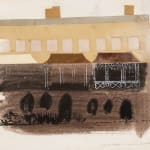John Piper 1903-1992
Cheltenham - Queen's Parade, 1939 circa
paper collage over gouache, watercolour and pen and ink
21.5 x 24 cm
8 1/2 x 9 1/2 in
8 1/2 x 9 1/2 in
titled
Piper was first drawn to collage after seeing a show of Picasso’s Papiers colles of 1912-13 at the Galeries Pierre in Paris. ‘[I] was deeply impressed by the intense poetry...
Piper was first drawn to collage after seeing a show of Picasso’s Papiers colles of 1912-13 at the Galeries Pierre in Paris. ‘[I] was deeply impressed by the intense poetry that he [Picasso] generated by putting two or three bits for Ingres there’ (John Piper quoted in Piper’s Places Richard Ingrams and John Piper, p.21). In 1938, Piper returned to architecture as his subject in his collages for the first time since his coastal pubs and villas of the early 1930s. For the previous five years he had been focusing more on his abstract works often with collage elements. This return to architecture comprised a group of collages of some Welsh nonconformist chapels which he exhibited at the London Gallery – his first solo show. By 1939, Piper had re-discovered his love of British topography and, initially due to his commission to produce the Shell Guide for Oxford, was touring around the towns and houses of Britain depicting in his work their forgotten beauty. Although watercolours were starting to dominate, he still incorporated collage into his works at this time.
This work of the Queen’s Parade, Cheltenham is sparse in style: coloured browns and yellows reflect the Cotswold stone with blocks of black ink alluding to the lower windows. The only detail in the work is the delicately applied white gouache which depicts the intricate white iron balustrade, pilasters and roof. In contract, the collage elements capture the simplicity of the regency structure of the upper half of the building echoing the colour palette of the watercolour below. Piper comments ‘I carried about a portfolio full of torn and cut strips of paper of different colours, (and a variety of shades of the same colour), saved or picked up at random and in the heat of the moment, stuck or pinned insecurely, then applied more carefully at leisure in the studio’ (ibid., p.22). Piper would have been drawn to the varied textures and colours of this row of houses. The work itself though depicting the Parade is semi-abstract, combining Piper’s interest in architecture and topography with his non-figurative work of the previous five years. At this time Piper was making a lithograph to accompany Betjeman’s article on Cheltenham for Signature in 1940 (the sketch for which we also have in the gallery). He would later use parts of the architecture of Cheltenham including the Parade for his commission for the murals at the British Embassy in Rio de Janiero in 1949.
This work of the Queen’s Parade, Cheltenham is sparse in style: coloured browns and yellows reflect the Cotswold stone with blocks of black ink alluding to the lower windows. The only detail in the work is the delicately applied white gouache which depicts the intricate white iron balustrade, pilasters and roof. In contract, the collage elements capture the simplicity of the regency structure of the upper half of the building echoing the colour palette of the watercolour below. Piper comments ‘I carried about a portfolio full of torn and cut strips of paper of different colours, (and a variety of shades of the same colour), saved or picked up at random and in the heat of the moment, stuck or pinned insecurely, then applied more carefully at leisure in the studio’ (ibid., p.22). Piper would have been drawn to the varied textures and colours of this row of houses. The work itself though depicting the Parade is semi-abstract, combining Piper’s interest in architecture and topography with his non-figurative work of the previous five years. At this time Piper was making a lithograph to accompany Betjeman’s article on Cheltenham for Signature in 1940 (the sketch for which we also have in the gallery). He would later use parts of the architecture of Cheltenham including the Parade for his commission for the murals at the British Embassy in Rio de Janiero in 1949.
Provenance
gifted by the Artist to the previous owner, and thence by descent1
of
7



